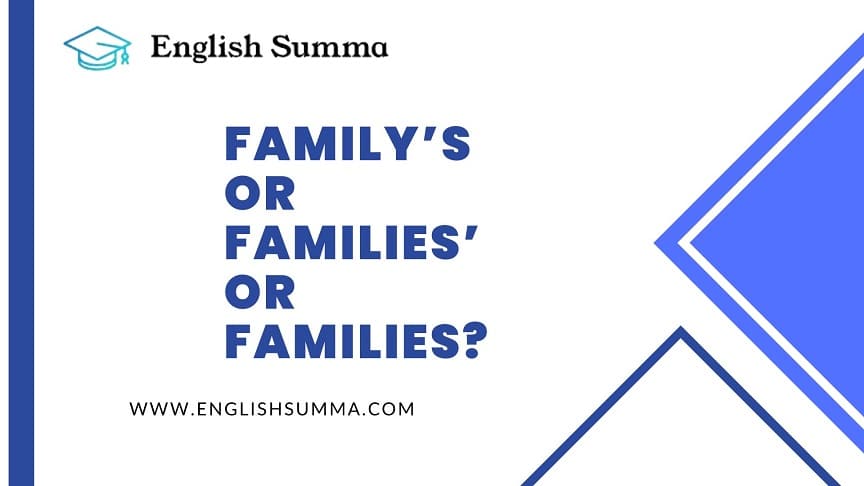In the intricate tapestry of the English language, the use of possessives adds a layer of complexity that can sometimes perplex even seasoned writers. The dilemma often arises when we encounter words like family’s possessive, families’, and families. Each variation serves a distinct purpose, highlighting the intricacies of possessive forms, both singular and plural. Let’s unravel the mystery and explore scenarios for each case.
Right Usage of Family’s or Families’ or Families?
Let’s discuss the correct usage of these possessives with example scenarios.
| Type | Form |
|---|---|
| Singular | Family |
| Plural | Families |
| Singular possessive | Family’s |
| Plural possessive | Families’ |
Singular Possessive: Family’s
When we talk about a singular entity or unit, such as an individual family, we use the singular possessive form, denoted by the apostrophe-‘s. Consider the following scenarios:
- Example 1: The Smith family’s house is adorned with beautiful flowers. Here, the possessive form indicates that the house belongs to the Smith family.
- Example 2: Sarah felt the weight of her family’s expectations on her shoulders. In this instance, the possessive form emphasizes the expectations specific to Sarah’s family.
Plural Possessive: Families’
Moving on to the plural possessive, we add an apostrophe after the plural form of the noun. This form is employed when discussing the possession of multiple families collectively:
- Example 1: During the holidays, the families’ celebrations echoed through the neighborhood. Here, the plural possessive form conveys that the celebrations belong collectively to several families.
- Example 2: The families’ decision to organize a joint event fostered a sense of community. In this case, the possessive form emphasizes the collaborative decision-making of multiple families.
Plural Non-Possessive: Families
The plural form without an apostrophe is used when referring to multiple families without indicating possession. It’s the standard plural form, employed in various contexts:
- Example 1: Many families attended the community event. The absence of the apostrophe indicates that multiple families were present at the event, without suggesting ownership.
- Example 2: Families from diverse cultures participated in the festival. In this scenario, the plural form is used to highlight the diversity of participants.
Distinguishing Between Physical and Non-Physical Possession
Understanding the nuances of possessives involves recognizing whether the possession is physical or non-physical.
Physical Possession
- Example 1: The family’s car was parked in the driveway. Here, the physical possession is the car owned by the singular family.
- Example 2: The families’ homes were decorated with festive lights. In this case, the physical possession is the homes collectively owned by multiple families.
Non-Physical Possession
- Example 1: The family’s love for music was evident in their home. The non-physical possession here is the intangible quality of love for music possessed by the singular family.
- Example 2: The families’ support was crucial for the success of the event. In contrast, the non-physical possession is the supportive attitude collectively shared by multiple families.
Navigating Standard Plurals and Plural Possessives
Understanding when to use a standard plural or a plural possessive can be pivotal in conveying the intended meaning.
Standard Plural
- Example 1: Families around the world celebrate diverse traditions. The standard plural form indicates the general celebration of traditions by multiple families worldwide.
- Example 2: Various cultures contribute to the richness of our society. In this instance, the standard plural form emphasizes the contributions of different cultures.
Plural Possessive
- Example 1: The families’ traditions were passed down through generations. Here, the plural possessive form indicates that specific traditions are collectively owned by multiple families.
- Example 2: Understanding different families’ perspectives is crucial for building a harmonious community. The possessive form emphasizes the unique perspectives owned by various families.
Embracing Language Diversity Across Cultures
English, as a language, transcends borders and embraces expressions from various cultures. The usage of possessives is no exception, reflecting the rich tapestry of linguistic diversity.
- Example 1: In Asian cultures, families’ bonds are often symbolized through shared meals. The possessive form highlights the bonds owned collectively by families in Asian cultures.
- Example 2: African cultures celebrate families in vibrant and communal ways. Here, the plural form without an apostrophe emphasizes the celebration of families without indicating specific ownership.
Conclusion: Navigating the Possessive Landscape
In conclusion, the choice between family’s, families’, and families hinges on the nuances of possession in English. Understanding when to use a singular or plural possessive, distinguishing between physical and non-physical possession, and navigating standard plurals versus plural possessives are essential for effective communication.
Embracing language diversity across various cultures adds another layer of richness to the way possessives are employed in our everyday discourse. So, the next time you find yourself pondering over the apostrophe, remember that it is your key to unlocking the possessive potential of the English language.
The answer lies in the traditional mindset and trust in physical assets. People believe that physical gold offers a sense of security that digital assets cannot match. This behavior significantly impacts the 1 Tola gold price in Pakistan.
Understanding these dynamics can help you make informed decisions when investing in gold. Do you follow the trends in these major trading centers? How does consumer behavior influence your gold purchasing decisions?

